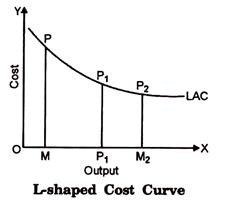The below mentioned article provides short notes on L-shaped cost curves.
At present some economists are of this view that the cost curves take the shape of ‘L’ and not ‘U’.
In support of this view the economists have given two reasons:
(i) Rapid technical progress brings about a short decline in unit cost up to a certain point and then stabilizes it.
ADVERTISEMENTS:
(ii) With the lapse of time the producer learns to produce at lower cost.
Further, they have said, that the shape of the long-run Cost curve will be something as is given in the figure below:
In this diagram first OM is output produced and PM is the Average Cost of production including both the Fixed and Variable Costs. When the output is expanded to OM2, the cost is P1M1 and when output is further increased to OM2, the cost is P2M2 which is almost equal to P1M1. From this point onwards, the cost per unit is stabilized, so that whatever the output, the cost per unit remains practically the same and the LAC comes to have L-shape. This means that the cost first falls over a range of output and then it neither rises nor falls but remains flat.
ADVERTISEMENTS:
Long-run Cost Curves Flatter:
This can be studied under the terms of Fixed and Variable Costs. As we are aware that in the long-run all costs are variable because, longer the period, the fewer costs are there which will be fixed. Mostly more costs will be variable. That is, in the long period, the total fixed costs can be varied, whereas in the short period, this amount is fixed absolutely.
In the short-run, if output is reduced, Average Cost will rise because the fixed costs will work out at a higher figure. But, in the run, fixed costs can be reduced, if the output is continued at the low level.
Therefore, it should be noted that Average Fixed Cost will be lower in the long period than in the short period. Further, the Variable Costs will not rise as sharply in the long period as in the short period because in the long period, the size of the firm can be increased to deal more economically with an increased output.
ADVERTISEMENTS:
Thus, it can be said that long-period Average Cost are flatter than the short-period cost curves, because in the long-period, the Average Fixed Cost comes down and it will be lower and Variable Costs will not rise sharply as in the short period.
